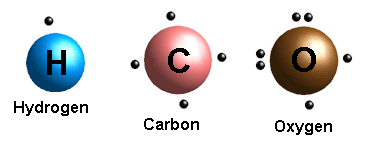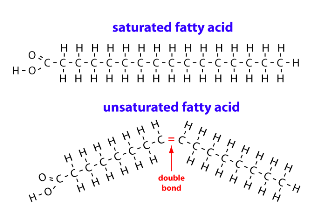Molecules in focus: Fat as the link between my work- and free-time Fat dominates my life at the moment! No, I am not getting obese and my cholesterol level is pretty alright! But lipids (that is fat, basically) are the molecules I am currently researching. Fat is also heavily discussed within my tri-athletic circle. And not that we are trumping each other in the consumption of skinny lattes and low-fat cheese… Fat dominates my life at the moment! No, I am not getting obese and my cholesterol level is pretty alright! But lipids (that is fat, basically) are the molecules I am currently researching. Fat is also heavily discussed within my tri-athletic circle. And not that we are trumping each other in the consumption of skinny lattes and low-fat cheese…What is fat, actually?
Fatty acids themselves are classified based on two criteria: the length of that carbon chain, i.e. the number of containing carbon atoms, and the number of the double bonds. If the chain contains no double bonds whatsoever, the FA is called saturated. If there is but one, the FA belongs to a monounsaturated class. More than one double bond means the fatty acid is polyunsaturated. Both types of classification are usually combined to describe a particular fatty acid. For example "FA 20:4" stands for a fatty acid with 20 carbons and 4 double bonds. Why we need lipids/fat? Fate of fat in our bodies Kinda different accumulation of fat... Among the lipid storage disorders, as these malfunctions are called, belong for instance: Gaucher’s disease, Farber’s disease, Niemann-Pick disease, or Fabry disease. Different classes of lipids accumulate in patients with the particular disorder. The accumulation of fatty acids with a very long chain (i.e. with high amount of carbon atoms) is specific for Zellweger syndrome, and x-dependant adrenoleukodystrophy. All of the diseases have two major features in common: there is no cure for them & the patients typically don’t survive more than a few years. Intensive research is conducted to understand the mechanism of the diseases so that possible treatment could be assessed. I am currently working on a big collaborative project that is investigating the molecular base of one of the lipids storage disorders. What I especially like about the project is the co-ordination of people with different expertise in a hunt to solve a sciencie question. Science has become so complex, that some questions cannot be answered by a single person but a joint effort of teams is required. Good and bad fat Mono- and especially polyunsaturated FA are attributed a galore of health benefits. Monounsaturated FA are found mostly in veggie oils. The most often mentioned polyunsaturated FA are the famous omega-3 and omega-6, also called as anti- and pro-inflammatory fatty acids. (The numbers 6 and 3 stands for the position of the last double bond within the carbon chain.) After these types of FA are released from the particular fat types, they are used for synthesis of compounds that either fight against or support inflammation in our bodies. Now, inflammation is important for us as it is a defending mechanism. However, too much of inflammation is not good, hence increased intake of pro-inflammatory FA is not beneficial either. Since the western diet is rich on the pro-inflammatory FA, we should make sure we consume enough of their counterbalance mates – the omega-3 FA. The latter are found in cold water fish and in some seeds such as flax seeds. Saturated FA (without any double bonds) were in the past linked with high cholesterol levels were linked with heart disease. Current research, however, cannot find the direct connections and saturated FA containing foods (such as butter) are being reprieved. Coconut oil is a health hit at the moment. With the highest content of saturated fatty acids! It contains FA that have a relatively short carbon chain. In general, the shorter the carbon chain the easier are the fatty acids utilized. That has both, dietetic and medical advantages. So called medium chain triglycerides (MCT) present in coconut oil contain FA with a relatively short carbon chain. On the other pole are the most harmful fats: the trans fatty acids. They are mostly created during a bad handling of good fats, particularly those containing the double bond(s). By the bad handling is usually meant heating them and moulding them into margarines. Fat for athletes
December 13, 2014, 18:26 (No. 137)Tom
Co se stane s olivovým olejem pokud ho zahřeju na pánvi, jak běžně dělám při přípravě jídla? |
|
Photo No. 87: Fructus cynosbati (Open in new window), Author: , Date:
You are here: Karolinas.net » Home » » Molecules in focus: Fat as the link between my work- and free-time



 Fri December 5, 2014, 14:25 |
Fri December 5, 2014, 14:25 |  14538x |
14538x | 




 Česky
Česky English
English

